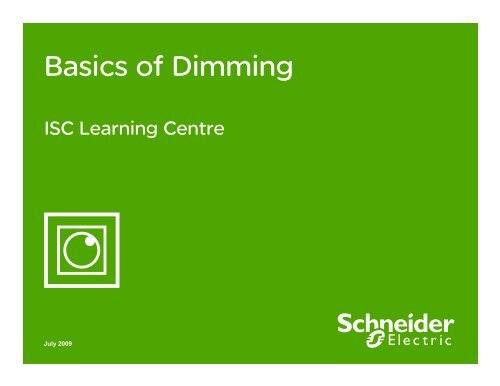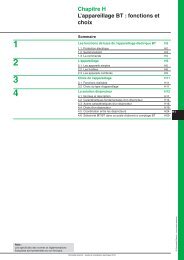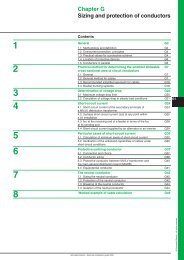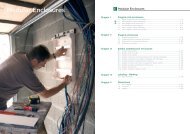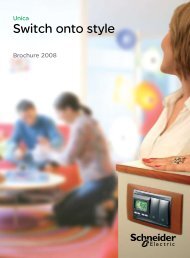How can I install the right dimmer to increase ... - Schneider Electric
How can I install the right dimmer to increase ... - Schneider Electric
How can I install the right dimmer to increase ... - Schneider Electric
Create successful ePaper yourself
Turn your PDF publications into a flip-book with our unique Google optimized e-Paper software.
Basics of Dimming<br />
ISC Learning Centre<br />
July 2009
Basics of Dimming<br />
> Dimmers<br />
Contents<br />
What is a <strong>dimmer</strong><br />
Dimmers & cus<strong>to</strong>mer benefits<br />
Dimmers at home<br />
Dimmers at <strong>the</strong> office<br />
Dimmers: technical choices<br />
Overview of <strong>the</strong> <strong>Schneider</strong> <strong>Electric</strong> offer<br />
<strong>Schneider</strong> <strong>Electric</strong> - Division - Name – Date<br />
2
Basics of Dimming<br />
> Dimmers<br />
What is a <strong>dimmer</strong><br />
●It's an adjustable transformer used<br />
<strong>to</strong> vary <strong>the</strong> level of lighting from 0 <strong>to</strong><br />
100% of lighting power<br />
●Fields of application<br />
0 100%<br />
<strong>Schneider</strong> <strong>Electric</strong> - Division - Name – Date<br />
3
Basics of Dimming<br />
> Dimmers<br />
Cus<strong>to</strong>mer benefits<br />
●Provide comfort & energy savings in day-<strong>to</strong>-day life<br />
● Step-less adjustment of lighting level<br />
● Consumption proportional <strong>to</strong> lighting level<br />
(Dim your light by 25% and save 20% of your energy)<br />
●Extended lifetime of filament lamps<br />
● Soft start eliminates inrush current<br />
● Decreasing line voltage by 10% doubles lifetime<br />
●Optimise working comfort & efficiency<br />
<strong>Schneider</strong> <strong>Electric</strong> - Division - Name – Date<br />
4
Basics of Dimming<br />
> Dimmers at home<br />
●Create a pleasant<br />
atmosphere in <strong>the</strong><br />
living room<br />
●Easily improve a twoway<br />
switch <strong>install</strong>ation<br />
Create<br />
a lighting atmosphere<br />
for each situation!<br />
Lighting plays an increasingly important role in<br />
modern living<br />
You're having friends over for a drink<br />
You're watching TV<br />
You're having a nice dinner<br />
<strong>Schneider</strong> <strong>Electric</strong> - Division - Name – Date<br />
5
Basics of Dimming<br />
> Dimmers at home<br />
●Reduce discomfort<br />
during <strong>the</strong> night or when<br />
you wake up<br />
by switching on<br />
with soft light<br />
When you get home late,<br />
get up early or go <strong>to</strong> <strong>the</strong> <strong>to</strong>ilet during <strong>the</strong> night,<br />
minimise inconvenience <strong>to</strong> o<strong>the</strong>r people by using<br />
dimmed lights!<br />
<strong>Schneider</strong> <strong>Electric</strong> - Division - Name – Date<br />
6
Basics of Dimming<br />
> Dimmers at home<br />
Save energy by reducing<br />
<strong>the</strong> level of lighting<br />
Up <strong>to</strong> 20%<br />
energy savings without losing your living comfort!<br />
● Reduce b<strong>right</strong>ness while you are watching TV (living room, corridor,<br />
kitchen)<br />
● Use <strong>the</strong> energy reduction function offered by our <strong>dimmer</strong> range (20%<br />
savings)<br />
<strong>Schneider</strong> <strong>Electric</strong> - Division - Name – Date<br />
7
Basics of Dimming<br />
> Dimmers at home<br />
●In summer, improve comfort<br />
and energy savings<br />
Save energy by controlling<br />
<strong>the</strong> speed of a fan instead<br />
of using air conditioning<br />
<strong>Schneider</strong> <strong>Electric</strong> - Division - Name – Date<br />
8
Basics of Dimming<br />
> Examples of dimming at home<br />
Remote Dimmers <strong>to</strong> control sofa,<br />
eating area and kitchen lights<br />
separately<br />
Push-But<strong>to</strong>ns for<br />
living room lights<br />
On Off + Dim near each door<br />
Kitchen light<br />
control<br />
Dim in <strong>the</strong> room<br />
<strong>to</strong> work properly<br />
on <strong>the</strong> computer<br />
Push-But<strong>to</strong>ns<br />
for living<br />
room lights<br />
On Off + Dim<br />
Double Dimmer unit<br />
- for outdoor lights<br />
- for living room light<br />
Push-But<strong>to</strong>ns for<br />
living room lights<br />
On Off + Dim near each door<br />
Dim in <strong>the</strong> bedroom<br />
near <strong>the</strong> door<br />
at <strong>the</strong> head<br />
of <strong>the</strong> bed<br />
<strong>Schneider</strong> <strong>Electric</strong> - Division - Name – Date<br />
9
Basics of Dimming<br />
> Dimmers at <strong>the</strong> office<br />
●Focus attention<br />
at conferences<br />
●By dimming <strong>the</strong> light<br />
in <strong>the</strong> room!<br />
Create scenes <strong>to</strong> be more efficient by focusing your<br />
participants' eyes on <strong>the</strong> screen!<br />
<strong>Schneider</strong> <strong>Electric</strong> - Division - Name – Date<br />
10
Basics of Dimming<br />
> Dimmers at <strong>the</strong> office<br />
●Save energy in corridors,<br />
entrance halls, etc.<br />
Keep just <strong>the</strong> necessary lighting level!<br />
<strong>Schneider</strong> <strong>Electric</strong> - Division - Name – Date<br />
11
Basics of Dimming<br />
> Dimmers at <strong>the</strong> office<br />
●Improve your working<br />
comfort<br />
Adapt <strong>the</strong> level of light in your room and on your screen<br />
<strong>to</strong> work without tiring your eyes!<br />
<strong>Schneider</strong> <strong>Electric</strong> - Division - Name – Date<br />
12
Basics of Dimming<br />
> Dimmers: technical choices<br />
Technically, <strong>dimmer</strong>s depend<br />
on <strong>the</strong> type of lights or loads 1/3<br />
●Technically, <strong>dimmer</strong>s depend on <strong>the</strong> type of lights or<br />
loads<br />
● Ohmic loads: in<strong>can</strong>descent lights, bulbs or 230 V AC<br />
halogen<br />
● Inductive loads: Low voltage halogen lights with<br />
ferromagnetic transformers or some fluorescent tubes<br />
(linear or lamp) with ferromagnetic transformers<br />
● Capacitive loads: Low voltage halogen lights with<br />
electronic transformers<br />
● Fluorescent tubes with electronic ballast (1-10 V DC)<br />
R<br />
C<br />
L<br />
● Halogen fluo-compact lights are not dimmable yet.<br />
+<br />
<strong>Schneider</strong> <strong>Electric</strong> - Division - Name – Date<br />
13
Basics of Dimming<br />
> Dimmers: technical choices<br />
Technically, <strong>dimmer</strong>s depend<br />
on <strong>the</strong> type of lights or loads 2/3<br />
●Dimming is performed by varying <strong>the</strong> incoming voltage of <strong>the</strong> light<br />
Closing phase control<br />
Opening phase control<br />
Adapted <strong>to</strong> Ohmic loads &<br />
Inductives loads<br />
For ohmic loads<br />
& inductive loads<br />
Adapted <strong>to</strong> Capacitive<br />
loads<br />
For capacitive loads<br />
<strong>Schneider</strong> <strong>Electric</strong> - Division - Name – Date<br />
14
Basics of Dimming<br />
> Dimmers: technical choices<br />
Technically, <strong>dimmer</strong>s depend<br />
on <strong>the</strong> type of lights or loads 3/3<br />
●Fluorescent tubes<br />
L<br />
N<br />
Dimmer<br />
100%<br />
Output<br />
+<br />
Ballast 1<br />
+<br />
Ballast 2<br />
CONVENTIONAL<br />
10%<br />
1-10Vdc<br />
Tube<br />
Tube<br />
<strong>Schneider</strong> <strong>Electric</strong> - Division - Name – Date<br />
15
Basics of Dimming<br />
> Dimmers: technical choices<br />
Technically, <strong>dimmer</strong>s depend<br />
on <strong>the</strong> type of lights or loads 3/3<br />
●Fluorescent tubes<br />
Alternative – Dimmer + Gateway KNX/DALI used in stand-alone<br />
DALI bus<br />
10%<br />
Dimmer<br />
100%<br />
Output<br />
1-10 Vdc<br />
Dimmable Fluorescent<br />
tubes<br />
<strong>Schneider</strong> <strong>Electric</strong> - Division - Name – Date<br />
16
Basics of Dimming<br />
> Dimmer selection parameters<br />
Parameters<br />
●Technical parameters<br />
● Type of light (In<strong>can</strong>descent, Halogen 230 V AC, Halogen low voltage,<br />
Fluorescent tube)<br />
● Power (in Watts = number of lights)<br />
● Neutral wire available or not (in case of refurbishment)<br />
● Combination with o<strong>the</strong>r functions (shutter control, heating control, etc.)<br />
●Cus<strong>to</strong>mer parameters<br />
● Touch, rotary <strong>dimmer</strong>,<br />
remote<br />
● Design & Colors<br />
● Light variation from several locations (depending on room layout)<br />
<strong>Schneider</strong> <strong>Electric</strong> - Division - Name – Date<br />
17
Basics of Dimming<br />
> Dimmer technologies<br />
<strong>Schneider</strong> <strong>Electric</strong>'s technical portfolio<br />
for dimming<br />
●We provide <strong>dimmer</strong>s compatible with R, L, C loads and 1-10 V DC<br />
fluorescent tubes<br />
●You <strong>can</strong> get <strong>the</strong>se solutions with:<br />
● Stand-alone <strong>dimmer</strong>s<br />
● Intelligent<br />
Home Control<br />
Residential – Small Buildings<br />
Wired wall-<br />
Infra-red<br />
red<br />
Radio-frequency<br />
mounted<br />
Buildings<br />
DIN rail <strong>dimmer</strong><br />
● BUS solution:<br />
KNX, LON<br />
IHC<br />
KNX, LON<br />
<strong>Schneider</strong> <strong>Electric</strong> - Division - Name – Date<br />
18
Basics of Dimming<br />
> Wired <strong>dimmer</strong>s<br />
Wired wall-mounted <strong>dimmer</strong>s<br />
●Principle: The product includes <strong>the</strong> dimming function<br />
●Several types of control:<br />
● Rotary Dimmers<br />
● For all lighting loads* & mo<strong>to</strong>rs (fans, etc.)<br />
● Step-Step rotary resistance<br />
● Memory function<br />
L- 230Vac<br />
N- 230Vac<br />
Dimmer<br />
Light<br />
● Comfort Rotary Dimmers<br />
● Add-on functions (energy saving function = 80% of max. power,<br />
Position indica<strong>to</strong>r, etc.)<br />
● Touch Dimmers<br />
● With or Without memory function<br />
(*except FLC= FLuo-Compact lights)<br />
<strong>Schneider</strong> <strong>Electric</strong> - Division - Name – Date<br />
19
Basics of Dimming<br />
> Wired <strong>dimmer</strong>s<br />
Wired wall-mounted <strong>dimmer</strong>s<br />
●Dim <strong>the</strong> light from several locations (doors, entrances, stairs, etc.)<br />
1<br />
Essential solution<br />
- Adjust <strong>the</strong> light level from several locations<br />
- All Push-But<strong>to</strong>ns <strong>can</strong> dim <strong>the</strong> light!!!<br />
L- 230Vac<br />
Super Dimmer<br />
Living room<br />
ceiling<br />
Alternative<br />
- Rotary with 3 memories<br />
N- 230Vac<br />
Push-But<strong>to</strong>ns<br />
PB1 Kitchen entrance<br />
PB2 Sliding glass window<br />
PB3 Garage door, etc.<br />
MTN577099<br />
In hall entrance<br />
RENOVATION<br />
<strong>Schneider</strong> <strong>Electric</strong> - Division - Name – Date<br />
20
Basics of Dimming<br />
> Dimmer components<br />
MERTEN International<br />
●<strong>How</strong> <strong>to</strong> order rotary and <strong>to</strong>uch <strong>dimmer</strong>s Three parts!<br />
Mechanism Function plate<br />
Deco. Frame<br />
(Insert)<br />
Complete Dimmer<br />
+ + =<br />
I.E MTN577099 MTN567719<br />
MTN489119<br />
- For R load<br />
- For L load<br />
- For C load<br />
- Super Dimmer<br />
- With/without memory<br />
- Power 400W- 600W-1000W<br />
- Standard rotary plate,<br />
- Comfort rotary plate<br />
- Standard sensor cover<br />
- Remote sensor cover<br />
- Range<br />
- Color<br />
- Single, double, etc.<br />
<strong>Schneider</strong> <strong>Electric</strong> - Division - Name – Date<br />
21
Basics of Dimming<br />
> Dimmers<br />
Our offer<br />
●Universal Comfort Rotary Dimmer<br />
Segments <strong>to</strong> indicate <strong>the</strong> light level<br />
2 segments always ON for people<br />
<strong>to</strong> find <strong>the</strong>ir way in <strong>the</strong> dark<br />
1-key memory<br />
(ON/OFF + b<strong>right</strong>ness<br />
saving)<br />
2-key memory<br />
(ON/OFF +<br />
b<strong>right</strong>ness saving)<br />
Indica<strong>to</strong>r light key<br />
Enable or disable <strong>the</strong> circular indication light<br />
On/off by pressing<br />
+ Rotary <strong>dimmer</strong><br />
Energy function key 80%<br />
Activated when <strong>the</strong> key is pressed<br />
for >5s with <strong>the</strong> light on.<br />
<strong>Schneider</strong> <strong>Electric</strong> - Division - Name – Date<br />
22
Basics of Dimming<br />
> Dimmers<br />
Infra-red control<br />
●Infra-red devices<br />
● Principle:<br />
● An IR emitter and one (or more) IR receiver(s)<br />
are associated<br />
● For all lights (loads)<br />
● One or more receivers in <strong>the</strong> walls<br />
● One emitter (remote)<br />
L- 230Vac<br />
N- 230Vac<br />
Wiring diagram<br />
E<br />
R<br />
● Main advantage:<br />
● control <strong>the</strong> light(s) without moving<br />
(from <strong>the</strong> sofa, etc.)<br />
More info ISC Training<br />
- Discover Merten International<br />
range of Dimmers<br />
<strong>Schneider</strong> <strong>Electric</strong> - Division - Name – Date<br />
23
Basics of Dimming<br />
> Dimmers<br />
Infra-red control<br />
●Example of association - Control lights<br />
and shutters from <strong>the</strong> same remote!!<br />
MTN577099<br />
Shutter 1<br />
(Living room TV)<br />
MTN586419<br />
MTN573998<br />
Channel 3<br />
Channel 4<br />
Outdoor light<br />
Living room light 1<br />
(sofa)<br />
Channel 1<br />
Channel 5<br />
Living room light 2<br />
(dinner table)<br />
Group Shutter 2<br />
(Living room)<br />
Channel 6<br />
Living room light 3<br />
(lights on outlets)<br />
Channel 2<br />
MTN570222<br />
Channel 7<br />
Kitchen light<br />
Channel 3 <strong>can</strong> be used several times as <strong>the</strong><br />
receivers are not in <strong>the</strong> same room<br />
Channels 9 & 10:<br />
Up & Down<br />
<strong>Schneider</strong> <strong>Electric</strong> - Division - Name – Date<br />
24
Basics of Dimming<br />
> Dimmers<br />
Wired <strong>dimmer</strong>s<br />
●Dimmers in control cabinet on DIN rail<br />
● Principle:<br />
● Push-but<strong>to</strong>n(s) give <strong>the</strong> information <strong>to</strong> <strong>the</strong> module. The module controls <strong>the</strong> light.<br />
● For all lights (all loads except FLC)<br />
● Main advantage:<br />
● Usually more powerful than wall-mounted products<br />
● Can be controlled by many push-but<strong>to</strong>ns in parallel<br />
● Good for renovation and maintenance due <strong>to</strong> location in <strong>the</strong> control cabinet<br />
Wiring diagram<br />
More info<br />
- Discover Merten International range of Dimmers<br />
L- 230Vac<br />
N- 230Vac R<br />
R<br />
<strong>Schneider</strong> <strong>Electric</strong> - Division - Name – Date<br />
25<br />
E
Basics of Dimming<br />
> Dimmers<br />
Radio-frequency control<br />
●RF system<br />
● Principle:<br />
● An RF emitter and one (or more) RF receiver(s)<br />
are associated<br />
● Each receiver <strong>can</strong> be controlled by several<br />
emitters<br />
● Each emitter <strong>can</strong> control several receivers<br />
● For all loads<br />
● One or more receivers in <strong>the</strong> walls<br />
● Main advantage:<br />
● Control of light through walls<br />
● Control of several light circuits<br />
● Control of scenes or scenarios<br />
● Wide range of receivers (mobile socket outlet,<br />
receiver for ceiling, in walls)<br />
E<br />
R<br />
More info<br />
- Discover Unica RF<br />
- Discover Connect RF on TSG<br />
- Understand Unica RF (in-class)<br />
- Understand Connect (in-class)<br />
<strong>Schneider</strong> <strong>Electric</strong> - Division - Name – Date<br />
26
Basics of Dimming<br />
> Dimmers<br />
Intelligent home control<br />
●System principle:<br />
● Central programmable unit located in <strong>the</strong> control cabinet<br />
● Several push-but<strong>to</strong>ns and lights are connected <strong>to</strong> <strong>the</strong><br />
central unit<br />
● Programming of function blocks <strong>to</strong> create <strong>the</strong> dimming<br />
function<br />
●For all loads (except FLC)<br />
●For residential market or small offices<br />
●Main advantage:<br />
● Flexibility of programming<br />
● Can manage many lights and o<strong>the</strong>r functions such as<br />
shutters, heating, etc.<br />
More info<br />
- Discover IHC on TSG<br />
- Understand IHC (In-class)<br />
<strong>Schneider</strong> <strong>Electric</strong> - Division - Name – Date<br />
27
Basics of Dimming<br />
> Dimmers<br />
KNX or LON field-bus<br />
●System principle<br />
● Intelligent components are connected <strong>to</strong>ge<strong>the</strong>r<br />
(push-but<strong>to</strong>ns, <strong>to</strong>uch panels, output modules, etc.)<br />
● A software <strong>to</strong>ol is used <strong>to</strong> create <strong>the</strong> dimming function<br />
●For all loads (except FLC)<br />
●For medium <strong>to</strong> large size buildings (and high end<br />
residential)<br />
●Main advantage:<br />
● Flexibility of programming<br />
● Can manage many lights and o<strong>the</strong>r functions such as<br />
shutters, heating, etc.<br />
More info<br />
- Discover our KNX training modules<br />
- Discover our Lon training module<br />
<strong>Schneider</strong> <strong>Electric</strong> - Division - Name – Date<br />
28
Basics of Dimming<br />
> Building - Fluorescent tube - Control ways<br />
Connection <strong>to</strong> our KNX System through<br />
our DALI Gateway<br />
L<br />
N<br />
DALI bus<br />
Push<br />
But<strong>to</strong>ns<br />
Dimmable Fluorescent<br />
tubes<br />
KNX Bus<br />
More info on buses<br />
- See our KNX and LON courses<br />
More info on DALI<br />
- See training module Basic of Lights<br />
<strong>Schneider</strong> <strong>Electric</strong> - Division - Name – Date<br />
29
Basics of Dimming<br />
> Building - Fluorescent tube - Control ways<br />
Connection with our LON DALI Gateway<br />
Power<br />
DALI<br />
Gateway<br />
LON<br />
3<br />
DALI<br />
DALI<br />
Power Supply<br />
O<strong>the</strong>r Option<br />
DALI<br />
Controller<br />
LON<br />
DALI<br />
DALI<br />
2<br />
max. 300m<br />
DALI Slaves<br />
max.<br />
64 EVG´s<br />
More info on buses<br />
- See our KNX and LON courses<br />
More info on DALI<br />
- See training module Basic of Lights<br />
<strong>Schneider</strong> <strong>Electric</strong> - Division - Name – Date<br />
30
Basics of Dimming<br />
> Intranet<br />
ISC Learning Centre<br />
From Swebi<br />
- Select "Operating Divisions”<br />
- Select "Europe”<br />
- Select "Installation Systems & Control”<br />
<strong>Schneider</strong> <strong>Electric</strong> - Division - Name – Date<br />
31
Basics of Dimming<br />
> Intranet<br />
ISC Learning Centre<br />
Then choose what you need in <strong>the</strong> menu<br />
<strong>Schneider</strong> <strong>Electric</strong> - Division - Name – Date<br />
32
Basics of Dimming<br />
> Intranet<br />
Where <strong>to</strong> get more info<br />
On <strong>the</strong> left, you have several choices:<br />
Communication <strong>to</strong>ols<br />
Catalogue<br />
Training<br />
<strong>Schneider</strong> <strong>Electric</strong> - Division - Name – Date<br />
33
ISC Learning Centre<br />
Thanks!<br />
Make <strong>the</strong> most of your energy


